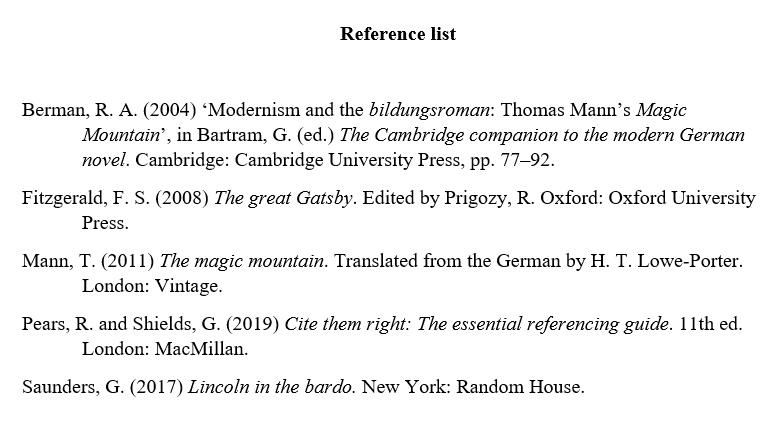
How to Reference in an Essay (9 Strategies of Top Students)

Chris Drew (PhD)
Dr. Chris Drew is the founder of the Helpful Professor. He holds a PhD in education and has published over 20 articles in scholarly journals. He is the former editor of the Journal of Learning Development in Higher Education. [Image Descriptor: Photo of Chris]
Learn about our Editorial Process
Are you feeling overwhelmed by referencing?
When you’re first asked to do referencing in an essay it can be hard to get your head around it. If it’s been a while since you were first taught how to reference, it can be intimidating to ask again how to do it!
I have so many students who consistently lose marks just because they didn’t get referencing right! They’re either embarrassed to ask for extra help or too lazy to learn how to solve the issues.
So, here’s a post that will help you solve the issues on your own.
Already think you’re good at referencing? No worries. This post goes through some surprising and advanced strategies for anyone to improve no matter what level you are at!
In this post I’m going to show you exactly how to reference in an essay. I’ll explain why we do it and I’ll show you 9 actionable tips on getting referencing right that I’m sure you will not have heard anywhere else!
The post is split into three parts:
- What is a Reference and What is a Citation?
- Why Reference? (4 Things you Should Know)
- How to Reference (9 Strategies of Top Students)
If you think you’ve already got a good understanding of the basics, you can jump to our 9 Advanced Strategies section.
Part 1: What is a Reference and What is a Citation?
What is a citation.
An in-text mention of your source. A citation is a short mention of the source you got the information from, usually in the middle or end of a sentence in the body of your paragraph. It is usually abbreviated so as not to distract the reader too much from your own writing. Here’s two examples of citations. The first is in APA format. The second is in MLA format:
- APA: Archaeological records trace the original human being to equatorial Africa about 250,000–350,000 years ago (Schlebusch & Jakobsson, 2018) .
- MLA: Archaeological records trace the original human being to equatorial Africa about 250,000–350,000 years ago (Schlebusch and Jakobsson 1) .
In APA format, you’ve got the authors and year of publication listed. In MLA format, you’ve got the authors and page number listed. If you keep reading, I’ll give some more tips on formatting further down in this article.
And a Reference is:
What is a Reference?
A reference is the full details of a source that you list at the end of the article. For every citation (see above) there needs to be a corresponding reference at the end of the essay showing more details about that source. The idea is that the reader can see the source in-text (i.e. they can look at the citation) and if they want more information they can jump to the end of the page and find out exactly how to go about finding the source.
Here’s how you would go about referencing the Schlebusch and Jakobsson source in a list at the end of the essay. Again, I will show you how to do it in APA and MLA formats:
- APA: Schlebusch, C. & Jakobsson, M. (2018). Tales of Human Migration, Admixture, and Selection in Africa. Annual Review of Genomics and Human Genetics , 11 (33), 1–24.
- MLA: Schlebusch, Carina and Mattias Jakobsson. “Tales of Human Migration, Admixture, and Selection in Africa.” Annual Review of Genomics and Human Genetics , vol. 11, no. 33, 2018, pp. 1–24.
In strategy 1 below I’ll show you the easiest and fool proof way to write these references perfectly every time.
One last quick note: sometimes we say ‘reference’ when we mean ‘citation’. That’s pretty normal. Just roll with the punches. It’s usually pretty easy to pick up on what our teacher means regardless of whether they use the word ‘reference’ or ‘citation’.
Part 2: Why Reference in an Essay? (4 Things you Should Know)
Referencing in an essay is important. By the time you start doing 200-level courses, you probably won’t pass the course unless you reference appropriately. So, the biggest answer to ‘why reference?’ is simple: Because you Have To!
Okay let’s be serious though … here’s the four top ‘real’ reasons to reference:
1. Referencing shows you Got an Expert’s Opinion
You can’t just write an essay on what you think you know. This is a huge mistake of beginning students. Instead this is what you need to do:
Top Tip: Essays at university are supposed to show off that you’ve learned new information by reading the opinions of experts.
Every time you place a citation in your paragraph, you’re showing that the information you’re presenting in that paragraph was provided to you by an expert. In other words, it means you consulted an expert’s opinion to build your knowledge.
If you have citations throughout the essay with links to a variety of different expert opinions, you’ll show your marker that you did actually genuinely look at what the experts said with an open mind and considered their ideas.
This will help you to grow your grades.
2. Referencing shows you read your Assigned Readings
Your teacher will most likely give you scholarly journal articles or book chapters to read for homework between classes. You might have even talked about those assigned readings in your seminars and tutorials.
Great! The assigned readings are very important to you.
You should definitely cite the assigned readings relevant to your essay topic in your evaluative essay (unless your teacher tells you not to). Why? I’ll explain below.
- Firstly, the assigned readings were selected by your teacher because your teacher (you know, the person who’s going to mark your essay) believes they’re the best quality articles on the topic. Translation: your teacher gave you the best source you’re going to find. Make sure you use it!
- Secondly, by citing the assigned readings you are showing your teacher that you have been paying attention throughout the course. You are showing your teacher that you have done your homework, read those assigned readings and paid attention to them. When my students submit an essay that has references to websites, blogs, wikis and magazines I get very frustrated. Why would you cite low quality non-expert sources like websites when I gave you the expert’s article!? Really, it frustrates me so, so much.
So, cite the assigned readings to show your teacher you read the scholarly articles your teacher gave to you. It’ll help you grow your marks.
3. Referencing deepens your Knowledge
Okay, so you understand that you need to use referencing to show you got experts’ opinions on the topic.
But there’s more to it than that. There’s actually a real benefit for your learning.
If you force yourself to cite two expert sources per paragraph, you’re actually forcing yourself to get two separate pieces of expert knowledge. This will deepen your knowledge!
So, don’t treat referencing like a vanity exercise to help you gain more marks. Actually view it as an opportunity to develop deeper understandings of the topic!
When you read expert sources, aim to pick up on some new gems of knowledge that you can discuss in your essays. Some things you should look out for when finding sources to reference:
- Examples that link ideas to real life. Do the experts provide real-life examples that you can mention in your essay?
- Facts and figures. Usually experts have conducted research on a topic and provide you with facts and figures from their research. Use those facts and figures to deepen your essay!
- Short Quotes. Did your source say something in a really interesting, concise or surprising way? Great! You can quote that source in your essay .
- New Perspectives. Your source might give you another perspective, angle or piece of information that you can add to your paragraph so that it’s a deep, detailed and interesting paragraph.
So, the reason we ask you to reference is at the end of the day because it’s good for you: it helps you learn!
4. Referencing backs up your Claims
You might think you already know a ton of information about the topic and be ready to share your mountains of knowledge with your teacher. Great!
So, should you still reference?
Yes. Definitely.
You need to show that you’re not the only person with your opinion. You need to ‘stand on the shoulders of giants.’ Show what other sources have said about your points to prove that experts agree with you.
You should be saying: this is my opinion and it’s based on facts, expert opinions and deep, close scrutiny of all the arguments that exist out there .
If you make a claim that no one else has made, your teacher is going to be like “Have you even been reading the evidence on this topic?” The answer, if there are no citations is likely: No. You haven’t.
Even if you totally disagree with the experts, you still need to say what their opinions are! You’ll need to say: “This is the experts’ opinions. And this is why I disagree.”
So, yes, you need to reference to back up every claim. Try to reference twice in every paragraph to achieve this.
Part 3: Strategies for How to Reference in an Essay (9 Strategies of Top Students)
Let’s get going with our top strategies for how to reference in an essay! These are strategies that you probably haven’t heard elsewhere. They work for everyone – from beginner to advanced! Let’s get started:
1. Print out your Reference Style Cheat Sheet
Referencing is hard and very specific. You need to know where to place your italics, where the commas go and whether to use an initial for full name for an author.
There are so many details to get right.
And here’s the bad news: The automated referencing apps and websites nearly always get it wrong! They tell you they can generate the citation for you. The fact of the matter is: they can’t!
Here’s the best way to get referencing right: Download a referencing cheat sheet and have it by your side while writing your essay.
Your assignment outline should tell you what type of referencing you should use. Different styles include: APA Style, MLA Style, Chicago Style, Harvard Style, Vancouver Style … and many more!
You need to find out which style you need to use and download your cheat sheet. You can jump onto google to find a cheat sheet by typing in the google bar:

Download a pdf version of the referencing style cheat sheet, print it out, and place it on your pinboard or by your side when writing your essay.
2. Only cite Experts
There are good and bad sources to cite in an essay.
You should only cite sources written, critiqued and edited by experts. This shows that you have got the skill of finding information that is authoritative. You haven’t just used information that any old person popped up on their blog. You haven’t just gotten information from your local newspaper. Instead, you got information from the person who is an absolute expert on the topic.
Here’s an infographic listing sources that you should and shouldn’t cite. Feel free to share this infographic on social media, with your teachers and your friends:

3. Always use Google Scholar
Always. Use. Google. Scholar.
Ten years ago students only had their online university search database to find articles. Those university databases suck. They rarely find the best quality sources and there’s always a big mix of completely irrelevant sources mixed in there.
Google Scholar is better at finding the sources you want. That’s because it looks through the whole article abstract and analyses it to see if it’s relevant to your search keywords. By contrast, most university search databases rely only on the titles of articles.
Use the power of the best quality search engine in the world to find scholarly sources .
Note: Google and Google Scholar are different search engines.
To use Google Scholar, go to: https://scholar.google.com
Then, search on google scholar using keywords. I’m going to search keywords for an essay on the topic: “What are the traits of a good nurse?”

If you really like the idea of that first source, I recommend copying the title and trying your University online search database. Your university may give you free access.
4. Cite at least 50% sources you found on your Own Research
Okay, so I’ve told you that you should cite both assigned readings and readings you find from Google Scholar.
Here’s the ideal mix of assigned sources and sources that you found yourself: 50/50.
Your teacher will want to see that you can use both assigned readings and do your own additional research to write a top essay . This shows you’ve got great research skills but also pay attention to what is provided in class.
I recommend that you start with the assigned readings and try to get as much information out of them, then find your own additional sources beyond that using Google Scholar.
So, if your essay has 10 citations, a good mix is 5 assigned readings and 5 readings you found by yourself.
5. Cite Newer Sources
As a general rule, the newer the source the better .
The best rule of thumb that most teachers follow is that you should aim to mostly cite sources from the past 10 years . I usually accept sources from the past 15 years when marking essays.
However, sometimes you have a really great source that’s 20, 30 or 40 years old. You should only cite these sources if they’re what we call ‘seminal texts’. A seminal text is one that was written by an absolute giant in your field and revolutionized the subject.
Here’s some examples of seminal authors whose old articles you would be able to cite despite the fact that they’re old:
- Education: Vygotsky, Friere, Piaget
- Sociology: Weber, Marx, C. Wright Mills
- Psychology: Freud, Rogers, Jung
Even if I cite seminal authors, I always aim for at least 80% of my sources to have been written in the past 10 years.
6. Reference twice per Paragraph
How much should you reference?
Here’s a good strategy: Provide two citations in every paragraph in the body of the essay.
It’s not compulsory to reference in the introduction and conclusion . However, in all the other paragraphs, aim for two citations.
Let’s go over the key strategies for achieving this:
- These two citations should be to different sources, not the same sources twice;
- Two citations per paragraph shows your points are backed up by not one, but two expert sources;
- Place one citation in the first half of the paragraph and one in the second half. This will indicate to your marker that all the points in the whole paragraph are backed up by your citations.
This is a good rule of thumb for you when you’re not sure when and how often to reference. When you get more confident with your referencing, you can mix this up a little.
7. The sum total of your sources should be minimum 1 per 150 words
You can, of course, cite one source more than once throughout the essay. You might cite the same source in the second, fourth and fifth paragraphs. That’s okay.

But, you don’t want your whole essay to be based on a narrow range of sources. You want your marker to see that you have consulted multiple sources to get a wide range of information on the topic. Your marker wants to know that you’ve seen a range of different opinions when coming to your conclusions.
When you get to the end of your essay, check to see how many sources are listed in the end-text reference list. A good rule of thumb is 1 source listed in the reference list per 150 words. Here’s how that breaks down by essay size:
- 1500 word essay: 10 sources (or more) listed in the reference list
- 2000 word essay: 13 sources (or more) listed in the reference list
- 3000 word essay: 20 sources (or more) listed in the reference list
- 5000 word essay: 33 sources (or more) listed in the reference list
8. Instantly improve your Reference List with these Three Tips
Here’s two things you can do to instantly improve your reference list. It takes less than 20 seconds and gives your reference list a strong professional finish:
a) Ensure the font size and style are the same
You will usually find that your whole reference list ends up being in different font sizes and styles. This is because you tend to copy and paste the titles and names in the citations from other sources. If you submit the reference list with font sizes and styles that are not the same as the rest of the essay, the piece looks really unprofessional.
So, quickly highlight the whole reference list and change its font to the same font size and style as the rest of your essay. The screencast at the end of Step 8 walks you through this if you need a hand!
b) List your sources in alphabetical order.
Nearly every referencing style insists that references be listed in alphabetical order. It’s a simple thing to do before submitting and makes the piece look far more professional.
If you’re using Microsoft Word, simply highlight your whole reference list and click the A>Z button in the toolbar. If you can’t see it, you need to be under the ‘home’ tab (circled below):

You’ve probably never heard of a hanging indent. It’s a style where the second line of the reference list is indented further from the left-hand side of the page than the first line. It’s a strategy that’s usually used in reference lists provided in professional publications.
If you use the hanging indent, your reference list will look far more professional.
Here’s a quick video of me doing it for you:
9. Do one special edit especially for Referencing Style
The top students edit their essays three to five times spaced out over a week or more before submitting. One of those edits should be specifically for ensuring your reference list adheres to the referencing style that your teacher requires.
To do this, I recommend you get that cheat sheet printout that I mentioned in Step 1 and have it by your side while you read through the piece. Pay special attention to the use of commas, capital letters, brackets and page numbers for all citations. Also pay attention to the reference list: correct formatting of the reference list can be the difference between getting the top mark in the class and the fifth mark in the class. At the higher end of the marking range, things get competitive and formatting of the reference list counts.
A Quick Summary of the 9 Top Strategies…

Follow the rules of your referencing style guide (and that cheat sheet I recommended!) and use the top 9 tips above to improve your referencing and get top marks. Not only will your referencing look more professional, you’ll probably increase the quality of the content of your piece as well when you follow these tips!
Here’s a final summary of the 9 top tips:
Strategies for How to Reference in an Essay (9 Strategies of Top Students)
- Print out your Reference Style Cheat Sheet
- Only cite Experts
- Always use Google Scholar
- Cite at least 50% sources you found on your Own Research
- Cite Newer Sources
- Reference twice per Paragraph
- The sum total of your sources should be minimum 1 per 150 words
- Instantly improve your Reference List with these Three Tips
- Do one special edit especially for Referencing Style

- Chris Drew (PhD) https://helpfulprofessor.com/author/chris-drew-phd/ Free Social Skills Worksheets
- Chris Drew (PhD) https://helpfulprofessor.com/author/chris-drew-phd/ 10 Reasons you’re Perpetually Single
- Chris Drew (PhD) https://helpfulprofessor.com/author/chris-drew-phd/ 20 Montessori Toddler Bedrooms (Design Inspiration)
- Chris Drew (PhD) https://helpfulprofessor.com/author/chris-drew-phd/ 21 Montessori Homeschool Setups
Leave a Comment Cancel Reply
Your email address will not be published. Required fields are marked *
- PRO Courses Guides New Tech Help Pro Expert Videos About wikiHow Pro Upgrade Sign In
- EDIT Edit this Article
- EXPLORE Tech Help Pro About Us Random Article Quizzes Request a New Article Community Dashboard This Or That Game Forums Popular Categories Arts and Entertainment Artwork Books Movies Computers and Electronics Computers Phone Skills Technology Hacks Health Men's Health Mental Health Women's Health Relationships Dating Love Relationship Issues Hobbies and Crafts Crafts Drawing Games Education & Communication Communication Skills Personal Development Studying Personal Care and Style Fashion Hair Care Personal Hygiene Youth Personal Care School Stuff Dating All Categories Arts and Entertainment Finance and Business Home and Garden Relationship Quizzes Cars & Other Vehicles Food and Entertaining Personal Care and Style Sports and Fitness Computers and Electronics Health Pets and Animals Travel Education & Communication Hobbies and Crafts Philosophy and Religion Work World Family Life Holidays and Traditions Relationships Youth
- Browse Articles
- Learn Something New
- Quizzes Hot
- Happiness Hub
- This Or That Game
- Train Your Brain
- Explore More
- Support wikiHow
- About wikiHow
- Log in / Sign up
- Education and Communications
- College University and Postgraduate
- Academic Writing
How to Cite an Essay
Last Updated: February 4, 2023 Fact Checked
This article was co-authored by Diya Chaudhuri, PhD and by wikiHow staff writer, Jennifer Mueller, JD . Diya Chaudhuri holds a PhD in Creative Writing (specializing in Poetry) from Georgia State University. She has over 5 years of experience as a writing tutor and instructor for both the University of Florida and Georgia State University. There are 10 references cited in this article, which can be found at the bottom of the page. This article has been fact-checked, ensuring the accuracy of any cited facts and confirming the authority of its sources. This article has been viewed 563,158 times.
If you're writing a research paper, whether as a student or a professional researcher, you might want to use an essay as a source. You'll typically find essays published in another source, such as an edited book or collection. When you discuss or quote from the essay in your paper, use an in-text citation to relate back to the full entry listed in your list of references at the end of your paper. While the information in the full reference entry is basically the same, the format differs depending on whether you're using the Modern Language Association (MLA), American Psychological Association (APA), or Chicago citation method.
Template and Examples

- Example: Potter, Harry.

- Example: Potter, Harry. "My Life with Voldemort."

- Example: Potter, Harry. "My Life with Voldemort." Great Thoughts from Hogwarts Alumni , by Bathilda Backshot,

- Example: Potter, Harry. "My Life with Voldemort." Great Thoughts from Hogwarts Alumni , by Bathilda Backshot, Hogwarts Press, 2019,

- Example: Potter, Harry. "My Life with Voldemort." Great Thoughts from Hogwarts Alumni , by Bathilda Backshot, Hogwarts Press, 2019, pp. 22-42.
MLA Works Cited Entry Format:
LastName, FirstName. "Title of Essay." Title of Collection , by FirstName Last Name, Publisher, Year, pp. ##-##.

- For example, you might write: While the stories may seem like great adventures, the students themselves were terribly frightened to confront Voldemort (Potter 28).
- If you include the author's name in the text of your paper, you only need the page number where the referenced material can be found in the parenthetical at the end of your sentence.
- If you have several authors with the same last name, include each author's first initial in your in-text citation to differentiate them.
- For several titles by the same author, include a shortened version of the title after the author's name (if the title isn't mentioned in your text).

- Example: Granger, H.

- Example: Granger, H. (2018).

- Example: Granger, H. (2018). Adventures in time turning.

- Example: Granger, H. (2018). Adventures in time turning. In M. McGonagall (Ed.), Reflections on my time at Hogwarts

- Example: Granger, H. (2018). Adventures in time turning. In M. McGonagall (Ed.), Reflections on my time at Hogwarts (pp. 92-130). Hogwarts Press.
APA Reference List Entry Format:
LastName, I. (Year). Title of essay. In I. LastName (Ed.), Title of larger work (pp. ##-##). Publisher.

- For example, you might write: By using a time turner, a witch or wizard can appear to others as though they are actually in two places at once (Granger, 2018).
- If you use the author's name in the text of your paper, include the parenthetical with the year immediately after the author's name. For example, you might write: Although technically against the rules, Granger (2018) maintains that her use of a time turner was sanctioned by the head of her house.
- Add page numbers if you quote directly from the source. Simply add a comma after the year, then type the page number or page range where the quoted material can be found, using the abbreviation "p." for a single page or "pp." for a range of pages.

- Example: Weasley, Ron.

- Example: Weasley, Ron. "Best Friend to a Hero."

- Example: Weasley, Ron. "Best Friend to a Hero." In Harry Potter: Wizard, Myth, Legend , edited by Xenophilius Lovegood, 80-92.

- Example: Weasley, Ron. "Best Friend to a Hero." In Harry Potter: Wizard, Myth, Legend , edited by Xenophilius Lovegood, 80-92. Ottery St. Catchpole: Quibbler Books, 2018.
' Chicago Bibliography Format:
LastName, FirstName. "Title of Essay." In Title of Book or Essay Collection , edited by FirstName LastName, ##-##. Location: Publisher, Year.

- Example: Ron Weasley, "Best Friend to a Hero," in Harry Potter: Wizard, Myth, Legend , edited by Xenophilius Lovegood, 80-92 (Ottery St. Catchpole: Quibbler Books, 2018).
- After the first footnote, use a shortened footnote format that includes only the author's last name, the title of the essay, and the page number or page range where the referenced material appears.
Tip: If you use the Chicago author-date system for in-text citation, use the same in-text citation method as APA style.
Community Q&A

You Might Also Like

- ↑ https://style.mla.org/essay-in-authored-textbook/
- ↑ https://owl.purdue.edu/owl/research_and_citation/mla_style/mla_formatting_and_style_guide/mla_works_cited_page_books.html
- ↑ https://utica.libguides.com/c.php?g=703243&p=4991646
- ↑ https://owl.purdue.edu/owl/research_and_citation/mla_style/mla_formatting_and_style_guide/mla_in_text_citations_the_basics.html
- ↑ https://guides.libraries.psu.edu/apaquickguide/intext
- ↑ https://guides.himmelfarb.gwu.edu/c.php?g=27779&p=170363
- ↑ https://owl.purdue.edu/owl/research_and_citation/apa_style/apa_formatting_and_style_guide/in_text_citations_the_basics.html
- ↑ http://libguides.heidelberg.edu/chicago/book/chapter
- ↑ https://librarybestbets.fairfield.edu/citationguides/chicagonotes-bibliography#CollectionofEssays
- ↑ https://libguides.heidelberg.edu/chicago/book/chapter
About This Article

To cite an essay using MLA format, include the name of the author and the page number of the source you’re citing in the in-text citation. For example, if you’re referencing page 123 from a book by John Smith, you would include “(Smith 123)” at the end of the sentence. Alternatively, include the information as part of the sentence, such as “Rathore and Chauhan determined that Himalayan brown bears eat both plants and animals (6652).” Then, make sure that all your in-text citations match the sources in your Works Cited list. For more advice from our Creative Writing reviewer, including how to cite an essay in APA or Chicago Style, keep reading. Did this summary help you? Yes No
- Send fan mail to authors
Reader Success Stories
Mbarek Oukhouya
Mar 7, 2017
Did this article help you?
Sarah Sandy
May 25, 2017
Skyy DeRouge
Nov 14, 2021
Diana Ordaz
Sep 25, 2016

Featured Articles

Trending Articles

Watch Articles

- Terms of Use
- Privacy Policy
- Do Not Sell or Share My Info
- Not Selling Info
Get all the best how-tos!
Sign up for wikiHow's weekly email newsletter
How to Write an Academic Essay with References and Citations
#scribendiinc
Written by Scribendi
If you're wondering how to write an academic essay with references, look no further. In this article, we'll discuss how to use in-text citations and references, including how to cite a website, how to cite a book, and how to cite a Tweet, according to various style guides.

You might need to cite sources when writing a paper that references other sources. For example, when writing an essay, you may use information from other works, such as books, articles, or websites. You must then inform readers where this information came from. Failure to do so, even accidentally, is plagiarism—passing off another person's work as your own.
You can avoid plagiarism and show readers where to find information by using citations and references.
Citations tell readers where a piece of information came from. They take the form of footnotes, endnotes, or parenthetical elements, depending on your style guide. In-text citations are usually placed at the end of a sentence containing the relevant information.
A reference list , bibliography, or works cited list at the end of a text provides additional details about these cited sources. This list includes enough publication information allowing readers to look up these sources themselves.
Referencing is important for more than simply avoiding plagiarism. Referring to a trustworthy source shows that the information is reliable. Referring to reliable information can also support your major points and back up your argument.
Learning how to write an academic essay with references and how to use in-text citations will allow you to cite authors who have made similar arguments. This helps show that your argument is objective and not entirely based on personal biases.
How Do You Determine Which Style Guide to Use?

Often, a professor will assign a style guide. The purpose of a style guide is to provide writers with formatting instructions. If your professor has not assigned a style guide, they should still be able to recommend one.
If you are entirely free to choose, pick one that aligns with your field (for example, APA is frequently used for scientific writing).
Some of the most common style guides are as follows:
AP style for journalism
Chicago style for publishing
APA style for scholarly writing (commonly used in scientific fields)
MLA style for scholarly citations (commonly used in English literature fields)
Some journals have their own style guides, so if you plan to publish, check which guide your target journal uses. You can do this by locating your target journal's website and searching for author guidelines.

How Do You Pick Your Sources?
When learning how to write an academic essay with references, you must identify reliable sources that support your argument.
As you read, think critically and evaluate sources for:
Objectivity
Keep detailed notes on the sources so that you can easily find them again, if needed.
Tip: Record these notes in the format of your style guide—your reference list will then be ready to go.
How to Use In-Text Citations in MLA
An in-text citation in MLA includes the author's last name and the relevant page number:
(Author 123)
How to Cite a Website in MLA

Here's how to cite a website in MLA:
Author's last name, First name. "Title of page."
Website. Website Publisher, date. Web. Date
retrieved. <URL>
With information from a real website, this looks like:
Morris, Nancy. "How to Cite a Tweet in APA,
Chicago, and MLA." Scribendi. Scribendi
Inc., n.d. Web. 22 Dec. 2021.
<https://www.scribendi.com/academy/articles/how_to_cite_a_website.en.html>
How Do You Cite a Tweet in MLA ?
MLA uses the full text of a short Tweet (under 140 characters) as its title. Longer Tweets can be shortened using ellipses.
MLA Tweet references should be formatted as follows:
@twitterhandle (Author Name). "Text of Tweet." Twitter, Date Month, Year, time of
publication, URL.
With information from an actual Tweet, this looks like:
@neiltyson (Neil deGrasse Tyson). "You can't use reason to convince anyone out of an
argument that they didn't use reason to get into." Twitter, 29 Sept. 2020, 10:15 p.m.,
https://twitter.com/neiltyson/status/1311127369785192449 .
How to Cite a Book in MLA
Here's how to cite a book in MLA:
Author's last name, First name. Book Title. Publisher, Year.
With publication information from a real book, this looks like:
Montgomery, L.M. Rainbow Valley. Frederick A. Stokes Company, 1919.
How to Cite a Chapter in a Book in MLA
Author's last name, First name. "Title of Chapter." Book Title , edited by Editor Name,
Publisher, Year, pp. page range.
With publication information from an actual book, this looks like:
Ezell, Margaret J.M. "The Social Author: Manuscript Culture, Writers, and Readers." The
Broadview Reader in Book History , edited by Michelle Levy and Tom Mole, Broadview
Press, 2015,pp. 375–394.
How to Cite a Paraphrase in MLA
You can cite a paraphrase in MLA exactly the same way as you would cite a direct quotation.
Make sure to include the author's name (either in the text or in the parenthetical citation) and the relevant page number.
How to Use In-Text Citations in APA
In APA, in-text citations include the author's last name and the year of publication; a page number is included only if a direct quotation is used:
(Author, 2021, p. 123)
How to Cite a Website in APA
Here's how to cite a website in APA:
Author, A. A., & Author, B. B. (Year, Month. date of publication). Title of page. https://URL
Morris, N. (n.d.). How to cite a Tweet in APA, Chicago, and MLA.
https://www.scribendi.com/academy/articles/how_to_cite_a_website.en.html
Tip: Learn more about how to write an academic essay with references to websites .
How Do You Cite a Tweet in APA ?
APA refers to Tweets using their first 20 words.
Tweet references should be formatted as follows:
Author, A. A. [@twitterhandle). (Year, Month. date of publication). First 20 words of the
Tweet. [Tweet] Twitter. URL
When we input information from a real Tweet, this looks like:
deGrasse Tyson, N. [@neiltyson]. (2020, Sept. 29). You can't use reason to convince anyone
out of an argument that they didn't use reason to get into. [Tweet] Twitter.
https://twitter.com/neiltyson/status/1311127369785192449

How to Cite a Book in APA
Here's how to cite a book in APA:
Author, A. A. (Year). Book title. Publisher.
For a real book, this looks like:
Montgomery, L. M. (1919). Rainbow valley.
Frederick A. Stokes Company.
How to Cite a Chapter in a Book in APA
Author, A. A. (Year). Chapter title. In Editor Name (Ed.), Book Title (pp. page range).
With information from a real book, this looks like:
Ezell, M. J. M. (2014). The social author: Manuscript culture, writers, and readers. In
Michelle Levy and Tom Mole (Eds.), The Broadview Reader in Book History (pp. 375–
394). Broadview Press.
Knowing how to cite a book and how to cite a chapter in a book correctly will take you a long way in creating an effective reference list.

How to Cite a Paraphrase in APA
You can cite a paraphrase in APA the same way as you would cite a direct quotation, including the author's name and year of publication.
In APA, you may also choose to pinpoint the page from which the information is taken.
Referencing is an essential part of academic integrity. Learning how to write an academic essay with references and how to use in-text citations shows readers that you did your research and helps them locate your sources.
Learning how to cite a website, how to cite a book, and how to cite a paraphrase can also help you avoid plagiarism —an academic offense with serious consequences for your education or professional reputation.
Scribendi can help format your citations or review your whole paper with our Academic Editing services .
Take Your Essay from Good to Great
Hire an expert academic editor , or get a free sample, about the author.

Scribendi's in-house editors work with writers from all over the globe to perfect their writing. They know that no piece of writing is complete without a professional edit, and they love to see a good piece of writing transformed into a great one. Scribendi's in-house editors are unrivaled in both experience and education, having collectively edited millions of words and obtained numerous degrees. They love consuming caffeinated beverages, reading books of various genres, and relaxing in quiet, dimly lit spaces.
Have You Read?
"Abstract vs. Introduction—What's the Difference?"
Related Posts

APA Style and APA Formatting

How to Research a Term Paper

MLA Formatting and MLA Style: An Introduction
Upload your file(s) so we can calculate your word count, or enter your word count manually.
We will also recommend a service based on the file(s) you upload.
English is not my first language. I need English editing and proofreading so that I sound like a native speaker.
I need to have my journal article, dissertation, or term paper edited and proofread, or I need help with an admissions essay or proposal.
I have a novel, manuscript, play, or ebook. I need editing, copy editing, proofreading, a critique of my work, or a query package.
I need editing and proofreading for my white papers, reports, manuals, press releases, marketing materials, and other business documents.
I need to have my essay, project, assignment, or term paper edited and proofread.
I want to sound professional and to get hired. I have a resume, letter, email, or personal document that I need to have edited and proofread.
Prices include your personal % discount.
Prices include % sales tax ( ).

Have a language expert improve your writing
Run a free plagiarism check in 10 minutes, automatically generate references for free.
- Knowledge Base
- Referencing
A Quick Guide to Referencing | Cite Your Sources Correctly
Referencing means acknowledging the sources you have used in your writing. Including references helps you support your claims and ensures that you avoid plagiarism .
There are many referencing styles, but they usually consist of two things:
- A citation wherever you refer to a source in your text.
- A reference list or bibliography at the end listing full details of all your sources.
The most common method of referencing in UK universities is Harvard style , which uses author-date citations in the text. Our free Harvard Reference Generator automatically creates accurate references in this style.
Make your writing flawless in 1 upload
Be assured that you'll submit flawless writing. Upload your document to correct all your mistakes.

Table of contents
Referencing styles, citing your sources with in-text citations, creating your reference list or bibliography, harvard referencing examples, frequently asked questions about referencing.
Each referencing style has different rules for presenting source information. For in-text citations, some use footnotes or endnotes , while others include the author’s surname and date of publication in brackets in the text.
The reference list or bibliography is presented differently in each style, with different rules for things like capitalisation, italics, and quotation marks in references.
Your university will usually tell you which referencing style to use; they may even have their own unique style. Always follow your university’s guidelines, and ask your tutor if you are unsure. The most common styles are summarised below.
Harvard referencing, the most commonly used style at UK universities, uses author–date in-text citations corresponding to an alphabetical bibliography or reference list at the end.
Harvard Referencing Guide
Vancouver referencing, used in biomedicine and other sciences, uses reference numbers in the text corresponding to a numbered reference list at the end.
Vancouver Referencing Guide
APA referencing, used in the social and behavioural sciences, uses author–date in-text citations corresponding to an alphabetical reference list at the end.
APA Referencing Guide APA Reference Generator
MHRA referencing, used in the humanities, uses footnotes in the text with source information, in addition to an alphabetised bibliography at the end.
MHRA Referencing Guide
OSCOLA referencing, used in law, uses footnotes in the text with source information, and an alphabetical bibliography at the end in longer texts.
OSCOLA Referencing Guide
Prevent plagiarism, run a free check.
In-text citations should be used whenever you quote, paraphrase, or refer to information from a source (e.g. a book, article, image, website, or video).
Quoting and paraphrasing
Quoting is when you directly copy some text from a source and enclose it in quotation marks to indicate that it is not your own writing.
Paraphrasing is when you rephrase the original source into your own words. In this case, you don’t use quotation marks, but you still need to include a citation.
In most referencing styles, page numbers are included when you’re quoting or paraphrasing a particular passage. If you are referring to the text as a whole, no page number is needed.
In-text citations
In-text citations are quick references to your sources. In Harvard referencing, you use the author’s surname and the date of publication in brackets.
Up to three authors are included in a Harvard in-text citation. If the source has more than three authors, include the first author followed by ‘ et al. ‘
The point of these citations is to direct your reader to the alphabetised reference list, where you give full information about each source. For example, to find the source cited above, the reader would look under ‘J’ in your reference list to find the title and publication details of the source.
Placement of in-text citations
In-text citations should be placed directly after the quotation or information they refer to, usually before a comma or full stop. If a sentence is supported by multiple sources, you can combine them in one set of brackets, separated by a semicolon.
If you mention the author’s name in the text already, you don’t include it in the citation, and you can place the citation immediately after the name.
- Another researcher warns that the results of this method are ‘inconsistent’ (Singh, 2018, p. 13) .
- Previous research has frequently illustrated the pitfalls of this method (Singh, 2018; Jones, 2016) .
- Singh (2018, p. 13) warns that the results of this method are ‘inconsistent’.
The terms ‘bibliography’ and ‘reference list’ are sometimes used interchangeably. Both refer to a list that contains full information on all the sources cited in your text. Sometimes ‘bibliography’ is used to mean a more extensive list, also containing sources that you consulted but did not cite in the text.
A reference list or bibliography is usually mandatory, since in-text citations typically don’t provide full source information. For styles that already include full source information in footnotes (e.g. OSCOLA and Chicago Style ), the bibliography is optional, although your university may still require you to include one.
Format of the reference list
Reference lists are usually alphabetised by authors’ last names. Each entry in the list appears on a new line, and a hanging indent is applied if an entry extends onto multiple lines.

Different source information is included for different source types. Each style provides detailed guidelines for exactly what information should be included and how it should be presented.
Below are some examples of reference list entries for common source types in Harvard style.
- Chapter of a book
- Journal article
Your university should tell you which referencing style to follow. If you’re unsure, check with a supervisor. Commonly used styles include:
- Harvard referencing , the most commonly used style in UK universities.
- MHRA , used in humanities subjects.
- APA , used in the social sciences.
- Vancouver , used in biomedicine.
- OSCOLA , used in law.
Your university may have its own referencing style guide.
If you are allowed to choose which style to follow, we recommend Harvard referencing, as it is a straightforward and widely used style.
References should be included in your text whenever you use words, ideas, or information from a source. A source can be anything from a book or journal article to a website or YouTube video.
If you don’t acknowledge your sources, you can get in trouble for plagiarism .
To avoid plagiarism , always include a reference when you use words, ideas or information from a source. This shows that you are not trying to pass the work of others off as your own.
You must also properly quote or paraphrase the source. If you’re not sure whether you’ve done this correctly, you can use the Scribbr Plagiarism Checker to find and correct any mistakes.
Harvard referencing uses an author–date system. Sources are cited by the author’s last name and the publication year in brackets. Each Harvard in-text citation corresponds to an entry in the alphabetised reference list at the end of the paper.
Vancouver referencing uses a numerical system. Sources are cited by a number in parentheses or superscript. Each number corresponds to a full reference at the end of the paper.
Is this article helpful?
Other students also liked.
- A Quick Guide to Harvard Referencing | Citation Examples
- APA Referencing (7th Ed.) Quick Guide | In-text Citations & References
How to Avoid Plagiarism | Tips on Citing Sources
More interesting articles.
- A Quick Guide to OSCOLA Referencing | Rules & Examples
- Harvard In-Text Citation | A Complete Guide & Examples
- Harvard Referencing for Journal Articles | Templates & Examples
- Harvard Style Bibliography | Format & Examples
- MHRA Referencing | A Quick Guide & Citation Examples
- Reference a Website in Harvard Style | Templates & Examples
- Referencing Books in Harvard Style | Templates & Examples
- Vancouver Referencing | A Quick Guide & Reference Examples
Scribbr APA Citation Checker
An innovative new tool that checks your APA citations with AI software. Say goodbye to inaccurate citations!


Citations - APA: Formatting - Essay, Reference List, Appendix, & Sample Paper
- Advertisements
- Artificial Intelligence: AI
- Audio Materials
- Books, eBooks & Pamphlets
- Class Notes, Class Lectures and Presentations
- Encyclopedias & Dictionaries (Reference Works)
- Government Documents
- Images, Charts, Graphs, Maps & Tables
- Magazine Articles
- Newspaper Articles
- Pesonal Communication (Interviews, Emails, & Telephone)
- Social Media
- Videos & DVDs
- When Creating Digital Assignments
- When Information Is Missing
- Works in a Foreign Language
- Works Quoted in Another Source (Secondary Source)
- In-Text Citations - Quoting & Paraphrasing
- Formatting - Essay, Reference List, Appendix, & Sample Paper
- Annotated Bibliography
Sample Papers
- Diane Hacker APA Sample Paper
If you are adding an appendix to your paper there are a few rules to follow that comply with APA guidelines:
- The Appendix appears after the References list
- If you have more than one appendix you would name the first appendix Appendix A, the second Appendix B, etc.
- The appendices should appear in the order that the information is mentioned in your essay
- Each appendix begins on a new page
- APA Sample Paper - with Appendix (Purdue OWL example)
Quick Rules for an APA Reference List
Your research paper ends with a list of all the sources cited in the text of the paper. Here are nine quick rules for this Reference list.
- Start a new page for your Reference list. Centre the title, References, at the top of the page.
- Double-space the list.
- Start the first line of each reference at the left margin; indent each subsequent line five spaces (a hanging indent).
- Put your list in alphabetical order. Alphabetize the list by the first word in the reference. In most cases, the first word will be the author’s last name. Where the author is unknown, alphabetize by the first word in the title, ignoring the words a, an, the.
- For each author, give the last name followed by a comma and the first (and middle, if listed) initials followed by periods.
- Italicize the titles of works: books, audiovisual material, internet documents and newspapers, and the title and volume number of journals and magazines.
- Do not italicize titles of parts of works, such as: articles from newspapers, magazines, or journals / essays, poems, short stories or chapter titles from a book / chapters or sections of an Internet document.
- In titles of non-periodicals (books, videotapes, websites, reports, poems, essays, chapters, etc), capitalize only the first letter of the first word of a title and subtitle, and all proper nouns (names of people, places, organizations, nationalities).
- If more than one place of publication is listed give the publisher's home office. If the home office is not given or known then choose the first location listed.
- << Previous: In-Text Citations - Quoting & Paraphrasing
- Next: Annotated Bibliography >>
- Last Updated: Oct 31, 2024 1:37 PM
- URL: https://libguides.lahc.edu/apa

IMAGES
COMMENTS
At college level, you must properly cite your sources in all essays, research papers, and other academic texts (except exams and in-class exercises). Add a citation whenever you quote, paraphrase, or summarize information or ideas from a source. You should also give full source details in a bibliography or reference list at the end of your text.
Remember to include all the articles you used in the references at the end of your essay. To cite in an essay, using APA style, you will need to include the author's name, the date of publication, and the page number where you found the information. ... For all other instances, write only the last name of the first author and add "et al ...
1500 word essay: 10 sources (or more) listed in the reference list; 2000 word essay: 13 sources (or more) listed in the reference list; 3000 word essay: 20 sources (or more) listed in the reference list; 5000 word essay: 33 sources (or more) listed in the reference list; 8. Instantly improve your Reference List with these Three Tips
To reference an essay using MLA style, add a citation after any information you found through a source, like facts or quotes. When citing the reference, include the author's name and the page number you pulled the information from in parenthesis, like "(Richards 456)." Once you've finished your essay, add a Words Cited page with all of ...
Add the word "In," then type the first initial and last name of the author or editor of the larger work. If the person named is an editor, add the abbreviation "Ed." in parentheses after their name. Add a comma, then type the title of the larger work in sentence case. Don't include any punctuation at the end of the title.
Tip: Learn more about how to write an academic essay with references to websites. How Do You Cite a Tweet in APA? APA refers to Tweets using their first 20 words. Tweet references should be formatted as follows: Author, A. A. [@twitterhandle). (Year, Month. date of publication). First 20 words of the. Tweet. [Tweet] Twitter. URL
Here are the same references essay examples of a website but in different styles: Example of an MLA reference; ... Some Specific References that Can Add Authenticity to Your Essay. Enhancing the authenticity of your essay involves incorporating particular types of references. These references provide depth and credibility to your work, making ...
Referencing styles. Each referencing style has different rules for presenting source information. For in-text citations, some use footnotes or endnotes, while others include the author's surname and date of publication in brackets in the text.. The reference list or bibliography is presented differently in each style, with different rules for things like capitalisation, italics, and ...
Start a new page for your Reference list. Centre the title, References, at the top of the page. Double-space the list. Start the first line of each reference at the left margin; indent each subsequent line five spaces (a hanging indent). Put your list in alphabetical order. Alphabetize the list by the first word in the reference.
The most common way to cite sources is to use a "Works Cited" or "References" list at the end of your research paper. "Works Cited" is the title of your list of citations when using the MLA (Modern Language Association) format; the title "References" is used when citing sources using APA (American Psychological Association) style.The list includes a citation for each of the sources you used to ...